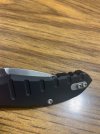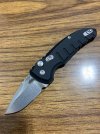Railsplitter
Gold Member
- Joined
- Oct 31, 2010
- Messages
- 8,109
I love this little knife but the position of the tip when closed causes me some concern. It isn't too bad right now. In its current state, I can catch the meat of my finger on the tip but I have to try. I fear that when I re-profile the edge, which I will want to do eventually, it will raise the tip just enough to be a legitimate concern.
Is there a way to lower the blade in the closed position without causing any problems elsewhere on the knife? I only need to lower it about 1 millimeter.


Is there a way to lower the blade in the closed position without causing any problems elsewhere on the knife? I only need to lower it about 1 millimeter.







